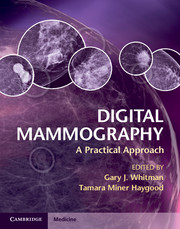Book contents
- Frontmatter
- Contents
- List of contributors
- Preface
- Acknowledgments
- Chapter 1 Detectors for digital mammography
- Chapter 2 Image acquisition
- Chapter 3 Preparing digital mammography images for interpretation
- Chapter 4 Image display and visualization in digital mammography
- Chapter 5 PACS, storage, and archiving
- Chapter 6 Interpretation of digital screening mammography
- Chapter 7 Efficacy of digital screening mammography
- Chapter 8 Artifacts in digital mammography
- Chapter 9 Mobile digital mammography
- Chapter 10 Procedures with digital mammography
- Chapter 11 Digital breast tomosynthesis
- Chapter 12 Breast computed tomography
- Chapter 13 Cases
- Chapter 14 Comparison of commercially available systems
- Index
- References
Chapter 2 - Image acquisition
Published online by Cambridge University Press: 05 December 2012
- Frontmatter
- Contents
- List of contributors
- Preface
- Acknowledgments
- Chapter 1 Detectors for digital mammography
- Chapter 2 Image acquisition
- Chapter 3 Preparing digital mammography images for interpretation
- Chapter 4 Image display and visualization in digital mammography
- Chapter 5 PACS, storage, and archiving
- Chapter 6 Interpretation of digital screening mammography
- Chapter 7 Efficacy of digital screening mammography
- Chapter 8 Artifacts in digital mammography
- Chapter 9 Mobile digital mammography
- Chapter 10 Procedures with digital mammography
- Chapter 11 Digital breast tomosynthesis
- Chapter 12 Breast computed tomography
- Chapter 13 Cases
- Chapter 14 Comparison of commercially available systems
- Index
- References
Summary
Introduction
One of the most recent advances in mammography is digital mammography. When first approved by the US Food and Drug Administration (FDA) in 2000, digital mammography systems were categorized as class III devices, because they were then considered novel systems for screening and diagnosing breast cancer [1]. The class III device category usually includes new technologies that have not been widely used and require proof of safety and effectiveness before the product can be approved for marketing. Other examples of class III devices include heart valves and orthopedic implants. As of January 2012, 22 digital mammography systems have been approved by the FDA (Table 2.1). From the time the first digital mammography system, the GE Senographe 2000D, was approved in 2000 until today, digital mammography has been validated by multiple scientific studies [2–4]. The benefits and risks of digital versus film-screen mammography have been well documented and well described. In November 2010 the FDA reclassified digital mammography systems as class II devices. Class I and class II devices pose lower risks and include adhesive bandages, wheelchairs, and many medical imaging technologies, such as magnetic resonance imaging (MRI) scanners and film-screen mammography. The class II device category usually requires submission of a premarket notification or a 510(k) to establish that the product is substantially equivalent to a device already on the market [1].
- Type
- Chapter
- Information
- Digital MammographyA Practical Approach, pp. 18 - 21Publisher: Cambridge University PressPrint publication year: 2012



